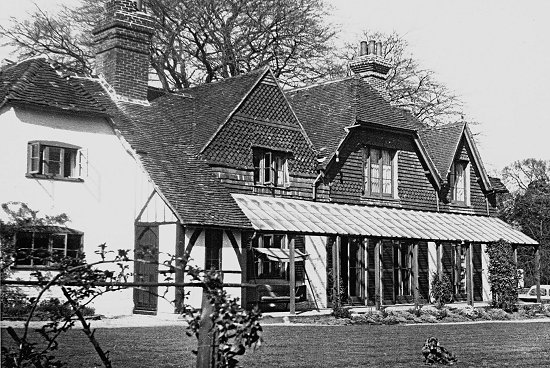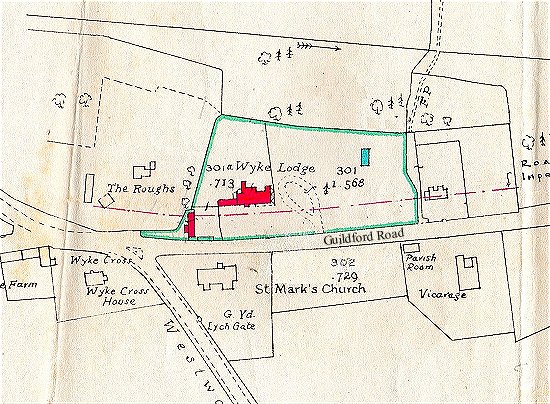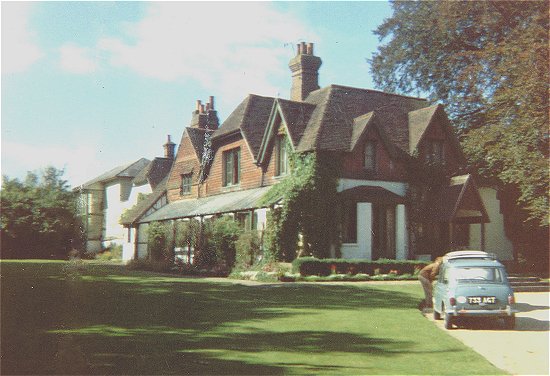|
Today, Wyke Lodge is a substantial dwelling house standing opposite Wyke Church across the busy Guildford to Ash road. However, when it was first established in the 17th century this area was all common land, referred to as 'the waste' of Wyke Manor. Some time before 1680 Richard Knight, a husbandman, enclosed about an acre of land on the common and built himself a cottage there. This came to the attention of George Woodroffe of Poyle, the lord of the manor of Wyke, and the situation had to be regularised, so on March 14th 1680 George Woodroffe leased the property to Richard Knight for 2s 6d per annum rent, for a term of 500 years which was effectively for ever. As with normal manorial protocol, Richard could not sell or sublet the property without the lord of the manor's permission. After Richard Knight's death the property descended to his daughter Sarah the wife of William Barnard, a carpenter, and in 1722 they sold the lease to Thomas Edes, a gentleman of Stoke next Guildford and John Bicknell, a yeoman of Worplesdon. By now the property had increased to three acres of land, the cottage was two tenements and there was a barn and outbuildings. In 1730 Anna Edes, widow of Thomas, sold her half share to John Bicknell for £33 and in 1736 he sold it all to Henry Spong, farmer of Worplesdon, for £115. In 1752 John Spong, eldest son of Henry, sold it to William Holmes, husbandman of Ash, with permission from George Woodroffe, lord of the manor. The Holmes family retained the property until in 1822 John Holmes and his four sisters who had jointly inherited it, sold it to William Jenkins, a cordwainer of Worplesdon, including the timber, trees and fruit on the land, for £250. William Jenkins sub-leased the property to Thomas Remington, a doctor of medicine in 1824 and when William died in 1829 and bequeathed it to his cousin Elizabeth, wife of John Adams of Putney, doctor Remington was still in residence. The deeds mention that the Lord of the Manor of Wyke in 1789 was Nicholas Nicholas Esq of Molecombe in Sussex, a trustee of the will of George Woodroffe (presumably a descendant of the George Woodroffe in 1680). In 1821 John Hunter sold the lordships of various manors including Wyke to William Hardyman Colyer, gent of Footscray Kent, and James Colyer, gent of Underriver near Sevenoaks Kent, and in 1844 the lord of the manor was 'Daniels trustees'. The first time an actual name of the property was mentioned was in 1836 when 'for some time past' it had been called 'Normandy Cottage', which is strange because it wasn't in Normandy at all - Wyke was a detached part of Worplesdon parish until 1890. In 1836 John Adams sold the cottage, which now included four acres of land, to Thomas Spong Esq of Fitzroy Square Middlesex for £215. There were further absentee owners when Thomas Spong sold it to William Ingle of Shoreditch Middx in 1844 for £219 10s, then William sold it to Lannoy Arthur Coussmaker Esq of Westwood in 1847 for £300. The Coussmaker family owned it until the 1930s. Wyke church was established in the 1840s and in 1848 Lannoy Arthur Coussmaker leased the Wyke Lodge premises, at this time called 'Wyke Cottage', to Reverend William Archibald Paxton, vicar of Wyke, so that it effectively became the first vicarage of the parish. It was subsequently occupied by other clerics until 1901. About 1840 it had also become the first village school, when a weatherboard building for the school had been built adjoining the cottage. The weatherboard section of the property is still there. The name Wyke Lodge appeared in the early 1900s when the property was occupied by a succession of the Coussmakers' tenants, until by 1944 it was owned by Major Douglas Leslie Cox of the Army Ordinance Corps. Then about 1946/47 Mrs Ruby Port-Lock bought the property. She commissioned a detailed survey from Harold Cox, architects of Camberley, which identified a number of problems; their report concluded "you must bear in mind that there are many snags … to balance against the many good points which make the property attractive and secluded". In 1947 Mrs Port-Lock received a quote for repair work on the roof, veranda and drains, from Raymond Kemp, builders of Camberley. Their plan of the property, annotated with their proposed drainage works, shows that Wyke Lodge and Wyke Lodge Cottage (on the sub-plot to the west) were still held as one property, but Wyke Cottage, built about 1930 on the adjacent plot to the east and formerly part of the Wyke Lodge holding, was now owned separately.
The plan is also annotated with the Guildford Road 'future improvement line' for a proposed dual carriage-way, which was never implemented but remained active and affected property values for many years. The property was owned by a military family for the next 30 years. Mrs Port-Lock's daughter married Major Allan Ramsey Dawe and while they were away on foreign postings the property was let, often to other military families. Between postings they would return and live in either Wyke Lodge or the Cottage, and in the 1960s they took a series of photos of the house at that time.
In 1966 they commissioned another survey by Messenger, May & Baverstock. This concluded "Three years ago we valued the property at £10,750. The value is now seriously affected by the road widening proposals. We estimate the value is now £11,000". In the mid-1970s they sold Wyke Lodge but retained the Cottage, finally selling that in the mid-1980s.
|



